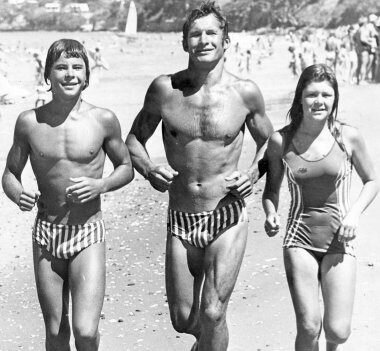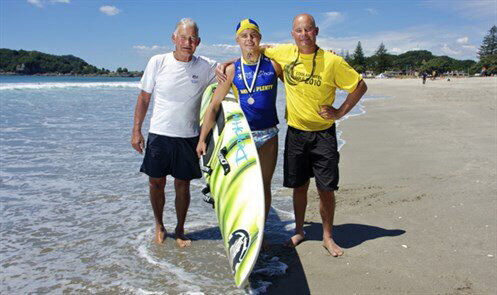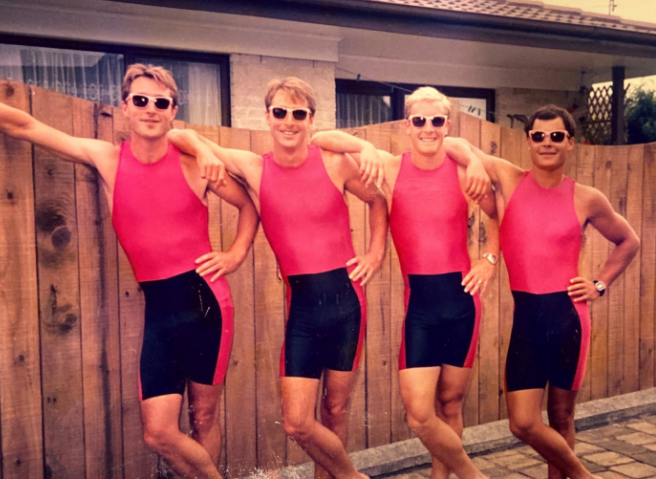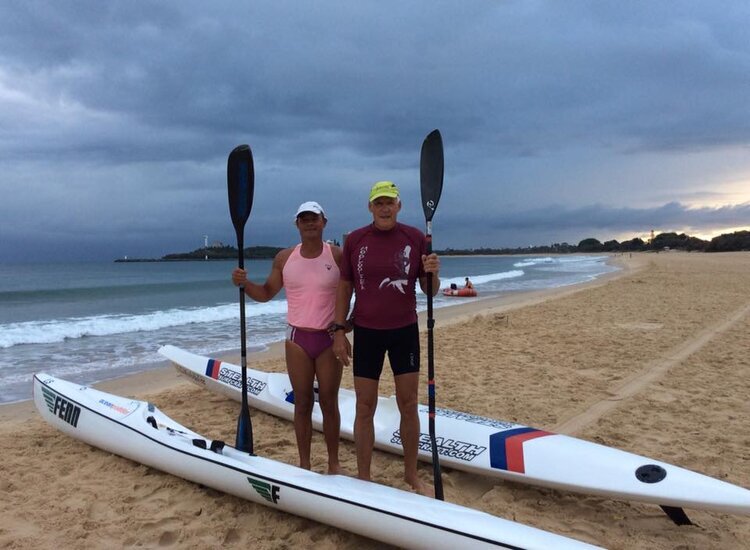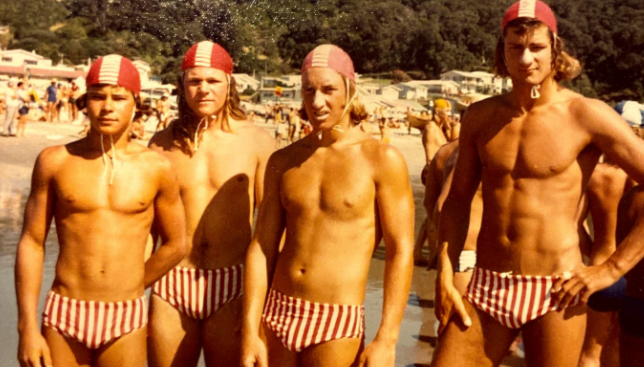Kim Harker - Omanawa, New Zealand
Endurance athlete and Masters champion, swimming has enabled me to make the most of so many sports.
“It was inevitable that I would be water safe and a strong swimmer. The Harker family lifestyle and values were strongly shaped by the surf life saving community, especially the Red Beach SLSC (Whangaparaoa Peninsula, New Zealand)
“Being able to swim well was a necessity. My father had an amazing natural ability to swim well, which he passed to me, and my sister Carol. Dad’s swimming, especially in the surf, had brought him significant competitive success, including numerous New Zealand ‘surf’ titles through the 1950’s, 1960’s and 1970’s.
“Many of my earliest swimming memories are based around the Red Beach SLSC community. 50-55 years on, the friendships made at the club are still strong - especially with the White and Glover families. The club was for families, positive and supportive, with a spread of age groups and abilities. There was plenty of action each week! Over the years, during the summer months, I developed into a high performing ‘surf’ competitor. Dad was well into his 40’s, successfully competing against many half his age, including me. It took a while before I could confidently put the ‘old man’ in his place.
“The Northern Regional Surf Champs and the SLSC camping weekends at Tairua (a two hour drive from Auckland, New Zealand) were great times. Although I always did well in my events at surf carnivals, the best memories are the enjoyment of connecting with the other families and the experiences we shared - the BBQ’s and weekends away with other club members, racing hard, striving for ‘club’ honors ahead of any individual recognition.
“The early influence of my father (and family) to join and then compete in surf life saving led me to gain success in sports such as water polo, The Ironman, The Coolangatta Gold endurance event, Masters Swimming (becoming a world champion in my 50’s) and Kayak endurance racing, including twice representing New Zealand at the World Masters championships. I never actually competed at an elite level in ‘swimming’, but swimming was an integral part of my elite sporting successes.”
The early years
“While swimming was predominately based around SLSC, Carol and I dipped our toes into structured swimming lessons when aged 8-9 years. Mum would drive us approximately 30 minutes to lessons which we attended each week at the Mt Eden pool in Auckland. I can remember one of my teachers there, Tom Johnson. Tom had a reputation worth travelling for, he was great with kids, a terrific teacher who achieved results. Tom started many young children on their swimming pathway, including swimmers who swam for New Zealand at the Olympics.
“Carol and I had additional lessons at our primary school, compulsory for all children in the 1960’s, with the classroom teachers doing their best to teach water skills and safety to a large number of students at the same time. Luckily for us, we did not rely on these lessons to improve our swimming. The Sunnyvale primary school three-lane pool was very shallow, 20m in length, unheated and cold. So school swimming lessons were restricted to the summer months.
“As well as our SLSC membership, we signed up to the Western Districts Swimming Club which included ‘club night’ each Thursday. The club was based at the Henderson High school pool, an outdoor unheated 33 ⅓ yds, six-lane pool. We fronted up each week of the season racing against the clock for PB’s, end of year trophies and the occasional ice cream treat. Even dad raced there until he was well into his 40’s.
“With my swimming improving, as a teenager I headed towards the surf, finding success as an age grouper, participating in weekend surf carnivals. I was also a member of the Auckland Senior Men's water polo team for four years at the New Zealand National Championships.”
From a suburban club to joining New Zealand’s top swimming squad
“Studying physiotherapy in the mid-1970s saw me living in Dunedin (New Zealand) and swimming under New Zealand Olympic coach Duncan Laing. Duncan and my father had been together in the New Zealand surf life-saving team - Duncan being the captain of Dad's first year on the team. This connection, friendship and mutual respect helped me ease my way into the swimming squad based at the 50m indoor Moana pool in Dunedin. The swimming scene was different to my Auckland swimming experiences. I embraced the opportunity to be in the ‘surf lane’ which trained alongside the ‘swimmers’ lanes’. I classified myself as a hit and miss trainer - no transport to get to the pool, financially stretched as a student, and overall not driven towards swimming. But I loved the way Duncan, and his family, included and supported me during my time in Dunedin.
“Although swimming was not a big part of my time over these Dunedin years, I took on the role of player-coach of the water polo team at physio school. Of course, Surf Life Saving was a part of these years, competing for the St. Kilda SLSC. With good friends (Rick Laing, Lars Humer and Rex Harding) we twice placed second at the New Zealand SLSC Nationals in the ‘surf teams’ event. I also played rugby in the local senior competition.”
The Mafia is still going strong today.
“It was after my physio studies, and establishing my own physio practices, first in Te Awamutu (1981/82) and then two years later in Hamilton, New Zealand, I became involved in the triathlon scene. With three other guys we created a triathlon squad (once labelled The Hamilton Mafia when we showed up at a triathlon in our ‘pink’ uniforms). Our swimming sessions had us training together at the then modern Te Rapa 50m indoor pool, which suited our training needs perfectly. Brothers Brad and Bryce Holmes and my brother-in-law, Tony Wilson, created a training environment that had the four of us pushing each other to our limits and celebrating each other's successes. I loved being part of this team - it was true mateship!
“Later on, another friend, Tony Lenz, established the Hamilton tri club, naming it ‘The Mafia’ after the original label put on us . . . the club is still going strong today.”
The Ironman calling
“During these years, the Hawaiian ‘Ironman’ was exploding onto the world endurance event calendar - a must-do event for triathletes, and multi-sport adventurers . . . including me. In 1982 a television documentary, with a Kiwi competitor featuring, instantly caught my attention. “I want a piece of this” I thought, and within two years I was the second Kiwi to be on the starting line at Kona. In 1984 I placed 28th and backed up in 1985 placing 42nd. In these events I finished the swimming leg in the top 10, with a time of mid-50 minutes for the 3.8km swim.”
Forced to swim
“Unfortunately for me and my blossoming triathlon career, and despite being a practising physiotherapist I was not immune to shin splints. It stopped my running and cycling in 1987 but increased my swimming training, under coach Dick Treloear. For the first time ever I was consistent with my swimming training, within three months quickly adapting to the training load, often swimming two sessions per day, at times 11 sessions a week. Dick’s sessions were significantly different to the squad sessions I experienced with Duncan in Dunedin. Dick had a belief that shorter and sharper sessions were the correct way forward for my swimming. It made me realise that it is not necessarily what you do, the key is doing it consistently. To fulfill my competitive ‘fix’ I was gaining success in master swimming meets. I broke numerous New Zealand Masters records and participated in ocean sea swim events. As my shins recovered, which took a good 5 months, swimming was my thing. But multisport events were more to my interest, and as the injuries recovered, there was one BIG challenge I wanted to face: The Xerox Challenge.”
Conquering the Xerox Challenge and onto deer farming
“Although there was no swimming, my natural competitive drive and interest in endurance events saw me enter, compete, and conquer the Xerox Challenge, a three week event where I and 67 other endurance multisport ‘nutters’ raced from Cape Reinga at the top of New Zealand’s North Island to the bottom of the South Island, finishing in Bluff. In total the event was more than 2000kms. We travelled the length of New Zealand by bike (on and off road), running and kayaking. I survived and finished it, placing 14th in a time of some 80-90 hours from memory. And another challenge was ticked off!
“After completing this epic event I hung up my bike, married, sold my physio practice, and bought a 1200 acre farm in upper Takaka, Golden Bay (top of the South Island of New Zealand). I became a deer farmer. For the next decade, farming and family was the priority, with my ‘fitness’ lifestyle taking a back seat.”
New Zealand Masters Records
“In 2001 we sold the farm and relocated to Christchurch. Our four children were aged between five and ten years, and I became a househusband. I joined the masters swimming squad at the QE pool (home of the 1974 Commonwealth Games and the QE2 Masters club). I was back swimming, and competing, again!
“The Masters group was an eclectic mix of people who trained hard, raced hard, enjoyed the post meet beers, and became very good friends. We were a group of swimmers from ‘surfing’ or ‘swimming’ backgrounds, which brought out the competitive spirit in us all.
“Like most sports clubs and training squads, I met many great friends who I still keep in contact with today; Craig Beeby and Pete Dawber, and many others.
Coach Roly encouraged us to compete, which had us racing in the local, national and international Masters swimming meets. Throughout the 2000’s I broke numerous New Zealand Master records in the age group 50-54 yrs, and 55-59yrs.
“It was at the 2008 World Masters Swimming Games in Perth that I won the 200m freestyle in a New Zealand Masters record time of 2:09mins in the 55-59 age group. I backed up in 2009 World Master Games in Sydney, placing 2nd and 3rd
Soon after, the family relocated again, moving back to New Zealand’s North Island settling in Papamoa, in the beautiful Bay of Plenty.”
Coolangatta Gold and more
“With the children competing for the Papamoa SLSC, I joined the club with them, competing in the local Masters surf carnivals, as well as testing myself in the Coolangatta Gold (Gold Coast, Australia) event on nine occasions. This event is 46kms of surf ski, sand running, swimming, paddle board - the swim event being in the middle over a distance of 3.5km, with a 2.1km ‘short course’ event for age groupers, which I have done for the last five of my nine Coolangatta Golds.
“I won my age group twice and have never been off the podium on the other occasions I have competed, except year one.
“My initial year (1984) of the ‘Coolangatta Gold’ was on the back of a very short period of preparation. Approximately five weeks prior to the event New Zealand Surf Life Saving received a call from the event organiser with two competitor invites to the event, all expenses paid, with the extra lure of two additional weeks on the Gold Coast as ‘extras’ in the movie being filmed about the event. I was on holiday at the time, taking a planned break before I started my preparation for the Hawaiian Ironman in late 1984. Turning down such an opportunity was not something that went through my mind, and before long I was attempting to cram much needed training for this new event I had never heard of, but realised it suited me to a ‘tee’. After the minimal training block and far from being in the ‘shape’ I needed to be, my toes were on the starting line. Being the competitor I am, I gave the event my best shot, but the lack of specific preparation was obvious. But life as a ‘movie extra’ for two weeks following the event was something I enjoyed, spending days in a tent on the beach, being on-call for the scene shots which were often hours apart, with nights enjoying the local Gold Coast bars and clubs, being treated like a VIP.
“1984 was a big year for me. Two new endurance events. In January the unplanned surf endurance ironman on the Gold Coast, followed in October the mecca of endurance, the Hawaiian Ironman. . . . Life was good. With the children competing for the Papamoa SLSC, I joined the club with them, competing in the local Masters surf carnivals, as well as testing myself in the Coolangatta Gold (Gold Coast, Australia) event on nine occasions. This event is 46kms of surf ski, sand running, swimming, paddle board - the swim event being in the middle over a distance of 3.5km, with a 2.1km ‘short course’ event for age groupers, which I have done for the last five of my nine Coolangatta Golds.
K1 and ocean kayaking
“Over recent years, I swim just once or twice a week. It has taken a back seat while I turn my attention to ocean ski paddling, and kayaking. This focus has earnt me selection to two World Masters championships for endurance kayaking, placing 12th in Hungary and 16th in Germany. The events are generally 19kms long, a circuit of 6x3km laps with a portage (a short run carrying your kayak) between each lap, from the second lap.
“Although swimming is less of a focus currently, I know I will return to more swimming, and possibly swim meets, in the future. “There’s also the lure of participating and completing (I am trying to remove the word competing from my mindset) in an Ironman one more time when I turn 65 in 2023.”
Kim - what is your favourite swim set that shows that you’re in good shape?
“5 x 400 freestyle on 6mins. I recall going 10 x 400 holding 5.15 - on 6mins - at the Kawana pool (Sunshine Coast. Australia) in 2008. This set has stuck with me as the benchmark of my swimming training sets.”
And, your children Kim, have they embraced the aquatic environment like you?
“All four children learnt to swim, and all developed to be strong technicians of swimming, using their skills predominantly in the SLSC arena, and on a few occasions in triathlons, such as the ‘Weetbix Tri’ series when they were at school.
“Currently I am looking forward to being on the start line with one of my daughters, and my sister, in a triathlon in late 2020 . . . a 1km lake swim, 45kms bike, with a 10.5kms trail run to test us all. Let's hope that New Zealand can keep COVID19 under control so the event takes place.”
Editor’s addition:
In our talks about his story, Kim shared with me that he has recently set a personal goal of holding a ‘handstand’ for five-seconds - totally independent. Each time he is at the gym, handstand practice is included, with a question of “can I still hold a handstand when I turn 70?” Good luck Kim!


